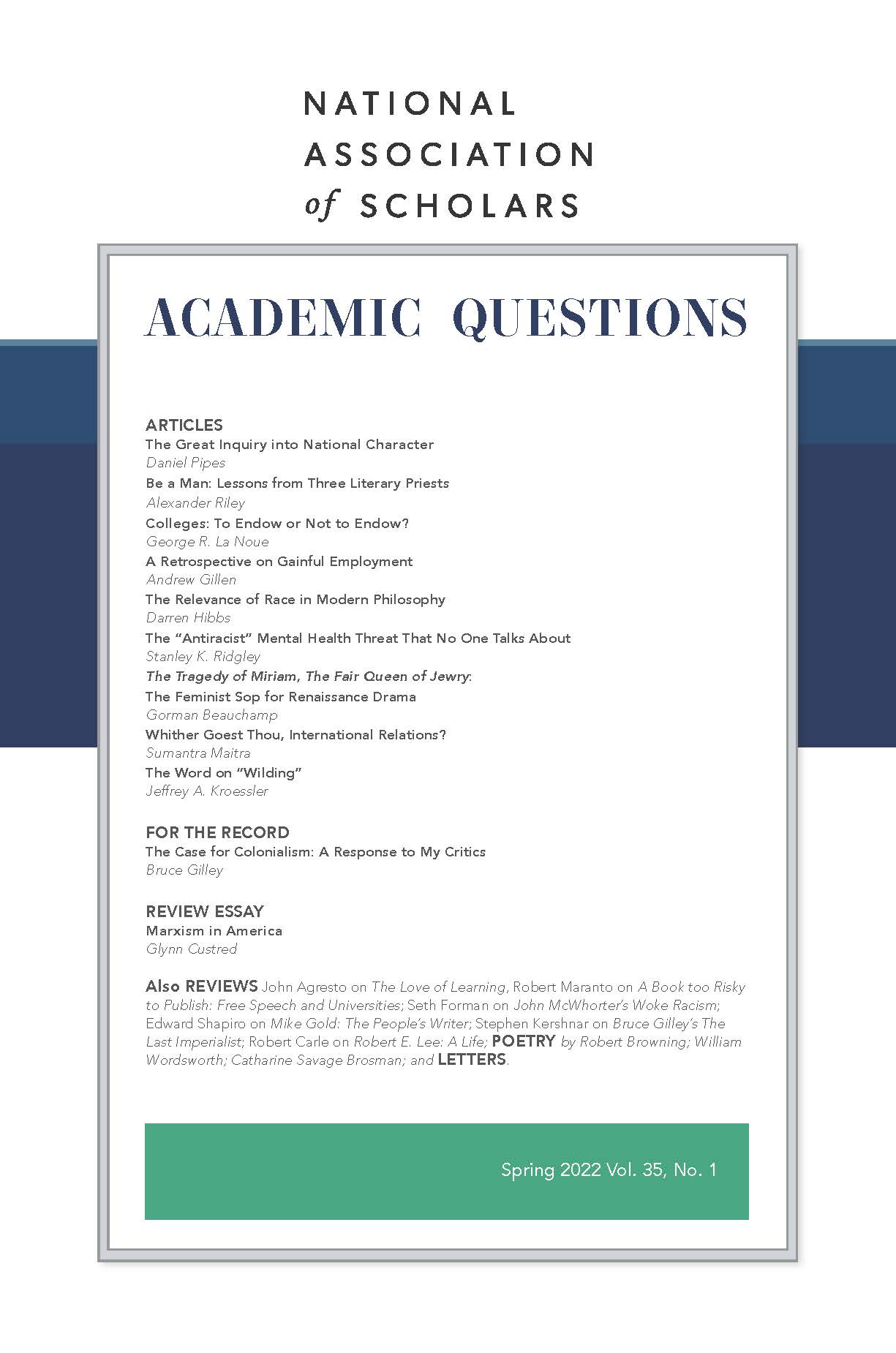Woke Racism: How a New Religion Has Betrayed Black America, John McWhorter, Portfolio/Penguin, 2021, pp. 201, $18.01 hardcover.
Seth Forman is the managing editor of Academic Questions, the quarterly journal of the National Association of Scholars; [email protected].
It would be hard to overstate the timeliness and gravity of John McWhorter’s Woke Racism, a book that delivers a stunning blow against the incoherent cruelty of “Third Wave Antiracism” (antiracism), the umbrella term he prefers for the ideology known also as “wokeism,” critical race theory, social justice, and identity politics. McWhorter sits at the apex of liberal influence as a professor of linguistics at Columbia University and a New York Times columnist, and his book arrives just as antiracism—an ideology which holds that society is a power struggle between warring racial, sexual, and gender groups—has greatly extended its reach. Antiracism’s precept that America was founded to secure white supremacy is ascendant in school curricula and the overt deference to race in hiring and promotion is driving policy in business, public bureaucracies, and cultural institutions. If any part of a racially blind liberalism is to be preserved, someone of McWhorter’s high profile and liberal credentials needed to recognize and denounce the broad destructive power of antiracism. McWhorter has done that, warning that antiracism is
losing innocent people their jobs. It is coloring academic inquiry, detouring it, and sometimes strangling it like kudzu. It forces us to render a great deal of our public discussion of urgent issues in double-talk any ten-year-old can see through. It forces us to start teaching our actual ten-year-olds . . . to believe in sophistry in the name of enlightenment. (5-6)
In so doing, McWhorter joins a now significant cadre of distinguished liberal critics—Bari Weiss, Andrew Sullivan, Peter Boghossian, among others—who have spoken out, sometimes at great personal cost, against what he labels a “totalitarian reign of ideological terror.” McWhorter stands out for his charm and personable style, and for his particular acuity at demonstrating how antiracism dehumanizes blacks, primarily by exempting them from the standards of behavior used to measure virtue in other groups. McWhorter also lends his support to vocational training as a key to social mobility for the disadvantaged, a move that groups such as the National Association of Scholars believe could enhance the fairness and integrity of higher education.
But he also pulls his punches, in all likelihood constrained by his commitment to “show that a pragmatic, effective, liberal, and even Democratic-friendly agenda for rescuing black America need not be founded on the tenets of this new religion.” (x) Perhaps as a result, the book crystallizes the implausibility of defeating antiracism while leaving the powerful interests that drive it virtually unmolested.
To his great credit, McWhorter recognizes that woke institutions in America are run by an overwhelmingly liberal managerial class without whose acquiescence antiracism could have never taken hold. It is to them that he dedicates this effort—"The New York Times reading, National Public Radio-listening people” who “have innocently fallen under the impression that pious, unempirical virtue signalling about race is a form of moral enlightenment and political activism” (xii). McWhorter wants liberals to realize that Third Wave Antiracism is foremost an attack on the liberalism they presumably cherish—the liberalism of individual rights, equality under the law, rational thinking, and free thought and speech.
This was the liberalism of the earlier “waves” of civil rights activism, but it has given way in the last decade to antiracism, which teaches that racism is the sole cause of all variations in socioeconomic outcomes between groups, that it is baked into the structure of society, and that it benefits whites and subjugates blacks.
To convince liberals that antiracism is irrational, McWhorter shrewdly declares it a religion. A self-described atheist himself, McWhorter knows that for secular liberals likening something to a religion—particularly to Christianity—serves as ironclad proof that it is impervious to logic. It is a superficial analogy; there are no antiracist equivalents of “love thy neighbor,” grace, or the hope of a transcendent afterlife, and even McWhorter writes at one point that antiracism’s “prosecution of sinners contrasts with Jesus’ embrace of them.” (171)
But like Christianity, antiracism has sacred texts (Between the World and Me, White Fragility, How to be an Antiracist); it has priests (Ta-Nehisi Coates, Ibram X. Kendi, Nikole Hannah-Jones, Kimberly Crenshaw); and it has adherents, often called “social justice warriors” but whom McWhorter prefers to label the “Elect,” to reflect the “ease with which they persecute people for not adhering to their religion.” (20)
However imperfect the analogy, McWhorter demonstrates that it takes a certain kind of blind faith to ignore the obvious contradictions inherent in so much of the antiracism “catechism”: when black people say you insult them, apologize, but don’t expect them to forgive you; don’t assume blacks like hip hop or basketball, but don’t expect blacks to assimilate to white social norms; silence on racism is violence, but elevate black and brown voices over your own, to name just a few.
For McWhorter, the biggest problem with antiracism is that by dismissing reason and empiricism, the Elect have imposed some very damaging policies. The Elect expect you to believe black boys get suspended and expelled from school more than other kids because teachers are racist. So school discipline is scaled back leaving innocent black students to suffer because “the simple fact is: black boys do commit more offenses in public schools than other kids. Period.” (99) The standards for admission to universities are also racist. So blacks are admitted with lower grades and test scores, resulting in an academic “mismatch” that leaves black students “in over their heads nationwide.” (106-107)
However eloquent and persuasive in lamenting the use of different standards to measure black behavior, McWhorter carefully avoids any serious consideration of ending affirmative action, the policy embodiment of racially preferential treatment. By the time he gets around to his three proposals for “bringing real change for blacks,” affirmative action is nowhere to be found. Whatever the virtues of his three policy recommendations—1. end the “war on drugs,” 2. teach all children to read by phonics, and 3. make vocational training as easy to access as college—they do nothing to address the practice of treating blacks as if they are damaged goods.
If the objective of the book is to “marginalize” antiracism, this is an obvious and unexplained omission, especially as McWhorter provides an unusually trenchant explanation of how special treatment by race creates a permanent victim class and furthers the cause of antiracism. He calls this the “ironic by-product” of the 1960s civil rights laws, which “chang[ed] the rules” to benefit blacks, thus depriving them of the ability to “say that we clawed our way to where we got.” (82) Lacking an “internally generated sense of what makes you legitimate,” blacks are drawn to the antiracist dogma that they are survivors in a feverishly racist world.
But McWhorter’s indictment of the 1960s “civil rights laws,” which “no one would want to rewind,” is cagey. It wasn’t the power to enforce desegregation granted by the Civil Rights Act of 1964 that deprived blacks of a chance for dignity. Blacks were the primary agents wringing these rights from the political system with a courage and nobility that has been universally lionized. The culprit was section 706(g) of Title VII of the Civil Rights Act, which allowed the government to compel “affirmative action.” A series of executive orders, court decisions, and regulatory rulings on affirmative action produced the concept of “disparate impact,” which enshrined into law and practice the fundamental antiracist doctrine: any inequality between racial groups is the result of racism. Today, the federal and state governments, private businesses, and the entire non-profit sector assume that statistical parity among racial groups would exist if not for discrimination, thus justifying racial quotas. As political scientist Richard Hanania points out, antiracism is really “just civil rights law.”1
By contrast, McWhorter sees the power of antiracism as stemming from cultural and attitudinal changes. The reason the woke have gotten away with authoritarian bullying, he claims, is “the remarkable change that has occurred in American life” that made being called a racist “all but equivalent to being called a pedophile.” If the label “racist” weren’t so lethal, he writes, antiracism would be a marginal movement “like the yippies of another era.” (13)
But antiracism thrives from the power granted by civil rights law to investigate and punish organizations suspected of noncompliance with strict statistical racial balance.2 Between 2000 and 2019, among only companies in the Fortune 500, almost $3 billion was dished out in civil rights settlements.3 And this says nothing of the billions paid out in the vast majority of cases, which are undisclosed, or the additional billions in government contracts, grants, and assistance that are threatened simply by the existence of policies that are broadly regarded as fair, but may have a “disparate impact.”
In this context, McWhorter’s advice to liberals to “just say no” to the antiracists seems rather peripheral. “What we must do about the Elect is to stand up to them,” he says. (172) Get “used to being called racist in the public square.” (172)
Steeling against verbal abuse alone will not defeat antiracism, which has been thoroughly bureaucratized. The DEI offices in universities and human resource departments in virtually all organizations together now employ millions whose jobs exist, at least in part, to enforce affirmative action and anti-discrimination laws. They make up a sizable chunk of the “NPR-listening” folks whom McWhorter believes he can persuade: “these people are not zealots. They are mostly thoroughly nice people,” he writes. (18) But for forty years a decisive number have been willing to sacrifice equal rights for equal racial outcomes, “equality” for “equity,” making author Michael Lind’s description seem apt: they are “technocratic managerial class progressives,” happy to feed hysteria over racism in order to implement a “profoundly illiberal form of social engineering,”4 This is why antiracism continues to gain strength despite widespread revulsion at its most prominent tenets.
It isn’t clear why McWhorter omits any discussion of affirmative action politics, antiracism’s most powerful weapon. But readers of Woke Racism might be reminded of the most striking result from the 2020 presidential election. In that year, the ultraliberal state of California voted for Democrat Joe Biden by a 30 percentage point margin over Donald Trump, yet also voted by nearly 15 percentage points against Proposition 16, a bid to restore state-sanctioned race-based affirmative action. In one fell swoop California liberals rejected the principal component of antiracism, while affirming allegiance to the political party that upholds it. In a less direct but just as certain way, Woke Racism does the same.
1 Richard Hanania, “Woke Institutions is Just Civil Rights Law,” richardhanania.substack.com, June 1, 2021.
2 Christopher Caldwell, “The Inequality of Equity,” National Review, May 17, 2021.
3 Philip Mattera, Big Business Bias: Employment Discrimination and Sexual Harassment at Large Corporations, Good Jobs First (January 2019), https://www.goodjobsfirst.org/bias.
4 Michael Lind, “The COVID Class War Heats Up,” Tablet, March 16, 2021.
Photo by Jameson Draper on Unsplash













